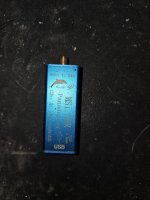dmg1969
Member
I am considering the leap into SDR and will likely start with an inexpensive RTL-SDR. Before starting, I have some questions. I figured I would ask experienced users here and be able to ask follow-up questions rather than spend hours trying to find the answers online. My main area areas of interest will be public services (Police, Fire and EMS) and perhaps air.
My questions in no particular order:
1. What exactly does the dongle come with? By that, I mean does it come with a built-in tuner interface or is that another program that I will download? In the online reading I have already done, I see reference to programs such as SDR# (SDRSharp), SDRTrunk, etc. I am assume those are the tuners and where you build your listening lists.
2. Related to the last part of the question above...I assume you are able to build "favorites lists" similar to that in a digital scanner (I have the HomePatrol 1 and 2)? When doing so, are you able to simply turn lists on and off at will?
3. Does the RTL-SDR (or the related SDR applications) support P25 Phase 2 along with Phase 1?
4. Are you able to program a TDMA or FDMA system with chosen sites and then just certain talk groups? Additionally, are you able to program it to receive ANY talk groups it finds on the programmed sites?
5. Are you able to input certain frequency ranges to sweep (such as that for aircraft, mil-air, etc.)?
Lastly, is there anything to know or consider before starting. Any hints, tips or tricks that will help someone totally new to the world of SDR?
I thank you in advance.
Dave
My questions in no particular order:
1. What exactly does the dongle come with? By that, I mean does it come with a built-in tuner interface or is that another program that I will download? In the online reading I have already done, I see reference to programs such as SDR# (SDRSharp), SDRTrunk, etc. I am assume those are the tuners and where you build your listening lists.
2. Related to the last part of the question above...I assume you are able to build "favorites lists" similar to that in a digital scanner (I have the HomePatrol 1 and 2)? When doing so, are you able to simply turn lists on and off at will?
3. Does the RTL-SDR (or the related SDR applications) support P25 Phase 2 along with Phase 1?
4. Are you able to program a TDMA or FDMA system with chosen sites and then just certain talk groups? Additionally, are you able to program it to receive ANY talk groups it finds on the programmed sites?
5. Are you able to input certain frequency ranges to sweep (such as that for aircraft, mil-air, etc.)?
Lastly, is there anything to know or consider before starting. Any hints, tips or tricks that will help someone totally new to the world of SDR?
I thank you in advance.
Dave


